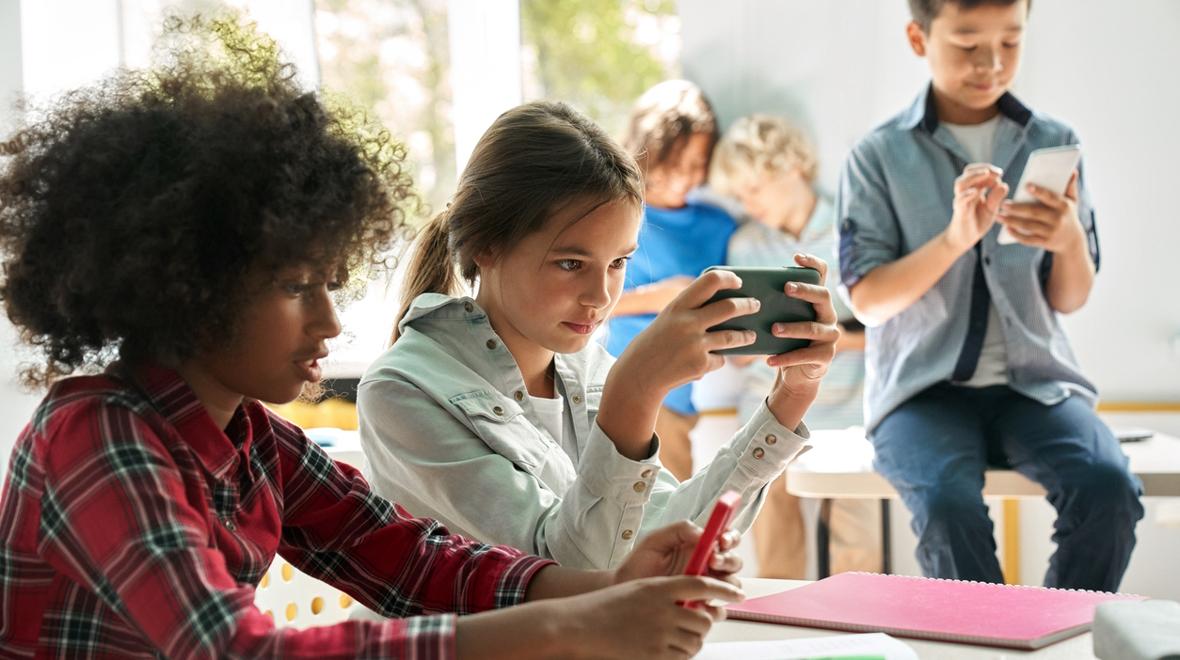
Photo:
iStock
As parents pour money into “dumb phones” and apps that promise to protect kids from adult predators and peer bullies, educators are also declaring enough is enough. According to a recent nationwide survey of nearly 3,000 of its members, the National Education Association found that 90 percent of educators are all for banning cell phones and personal devices during instruction time.
Galvanized by the U.S. surgeon general’s recent call to require tobacco-style warning labels on social media sites and backed by mounting research showing that 24/7 internet access is, indeed, making today’s generation of kids more anxious than ever, parents and teachers are sounding the alarm: Cell phones are not only contributing to learning loss, but are also intensifying a youth mental health crisis.
As a new school year gets underway, districts are facing a Sisyphean challenge. Schools must prioritize student wellness and classroom engagement, all while supporting teacher autotomy, preparing students for a tech-driven society, and taking into account the diverse communication and access needs of students.
Here’s how Seattle-area schools are responding to this challenge.
|
For more support and resources surrounding the youth mental health crisis, screen time and social media, and the importance of play, visit ParentMap’s Antidote for the Anxious Generation page. |
Seattle Public Schools bans cell phones in two North Seattle middle schools
As part of a new pilot program, Seattle Public Schools (SPS) is banning cell phones at Hamilton International Middle School in Wallingford, and Robert Eagle Staff Middle School in Licton Springs for the 2024–2025 school year. SPS is our state’s largest school district, with an enrollment of nearly 50,000 students.
In an email to ParentMap, SPS communications specialist Sophia Charchuk underscored that the district is aiming to balance the benefits of using technology as a learning tool with the need to reduce distractions caused by phones in the classroom. She explained that this pilot approach will enable the district to test the feasibility of school-wide bans while evaluating their effectiveness and gathering feedback from the community.
In an email sent to parents of Lincoln High School students on Aug. 30, SPS Principal Corey Eichner informed families that the school is standardizing a “phone zone” policy this year, which designates specific areas in each classroom where students must store their cell phones during class time. Eichner clarified that while Lincoln students are still allowed to use their devices before and after school, during passing periods, at lunch and for specific learning activities or accommodations, unauthorized use will result in escalating consequences, ranging from verbal reminders to meetings with administrators and parents to establish a digital citizenship contract. Lincoln High School is also in North Seattle’s Wallingford neighborhood.
|
Lake Washington High School aims to reel in both earbud and phone use
The Lake Washington School District (LWSD), the state’s second-largest public school district with nearly 30,000 students, acknowledged in an email to ParentMap that student cell phone use during the school day is a concern for students, staff and families. However, Shannon Parthemer, LWSD director of communications, also stated, “At this time, we have not made any changes to our existing cell phone policies for students.” She added that LWSD remains “committed to regularly reviewing our policies to ensure they meet the needs of our students, staff and families.”
While LWSD’s rules for use of district-provided laptops are extensively detailed on the district’s website, there are no specific cell phone policies noted.
However, the 2024–2025 student handbook for Lake Washington High School states that personal technology, including phones and earbuds, must be kept out of use and out of sight during learning times unless a teacher grants specific permission. The policy outlines a series of escalating consequences for unauthorized use, starting with the teacher keeping the device until the end of the class period and progressing to administrative involvement and potential detention for repeated offenses. Additionally, the policy states that severer violations involving personal technology, such as bullying or academic dishonesty, may result in consequences beyond the standard policy.
Tacoma schools invite principals to lead policy plans
Tacoma Public Schools (TPS) is Washington’s fourth-largest district, serving nearly 27,000 students. Via email, Chief Communications Officer Tanisha Jumper stated that TPS does not currently have a district-wide policy on student cell phone use. Instead, principals at individual schools set expectations for personal electronic devices. Jumper noted that TPS does not have any school-wide cell phone bans in place at this time.
TPS Principal Amber Samuels outlined a clear cell phone policy in a public letter to parents and guardians of her Gray Middle School students. The policy states that students must leave cell phones and other personal devices in lockers or backpacks for the duration of the school day in order to minimize distractions and support a focused learning environment. Her letter explains that for emergencies, students may use phones in the school’s main office or nurse’s office, and the school will assist in relaying messages as needed. Consequences for violating the policy include confiscation of the device, with first offenses resulting in the phone being returned to the student at the end of the day; second offenses requiring a parent pickup of the phone; and repeated offenses leading to further discussions with parents and school administration.
Bellevue School District keeps cell phone policy from 12 years ago
Bellevue School District (BSD) has maintained the same cell phone policy since 2012, according to an email to ParentMap from John Harrison, BSD’s chief of staff. The policy restricts the use of telecommunications devices, including cell phones, to before and after school hours, during lunch breaks or in emergencies. Any use that disrupts the learning environment, violates privacy or compromises academic integrity is prohibited under this policy, with violations resulting in disciplinary actions, including potential suspension or expulsion. The policy allows school officials to confiscate devices and conduct searches based on reasonable suspicion, with parents or law enforcement involved in cases where legal violations are suspected.
Harrison acknowledged that “implementation [of this policy] has been inconsistent between teachers and schools.” He added that in response to growing concerns about student phone use since the onset of the COVID-19 pandemic and the rise of online learning, BSD’s school board plans to revise the policy based on lessons learned from last year’s experiences at secondary schools.
Issaquah School District allows schools to determine their own policies
The Issaquah School District (ISD) does not currently have a district-wide cell phone policy, instead allowing each school to develop its own rules with input from students, staff and families.
As a result, policies differ from campus to campus. For example, at Maywood Middle School, students are expected to put their phones away for the full duration of the school day, while Pine Lake Middle School leaves cell phone rules up to individual teachers, who decide on restrictions as part of their regular classroom behavior policies.
While the specific language varies from policy to policy at the various ISD high schools, generally phones for high schoolers are expected to be put away during instructional time unless given explicit teacher permission to use personal devices as part of the class.
In an email to ParentMap, ISD’s director of communication, Wendy Castleman, noted that the ISD school board recently began discussions on potentially creating a district-wide policy, citing reasons such as prioritizing student mental health, reducing distractions and increasing engagement in the classroom. “Our current stance is that we support our schools as they develop methods and practices,” Castleman stated.
Highline Public Schools remains vague about cell phone policies, but gets specific about social media
Highline Public Schools (HPS) does not have a district-wide policy regarding cell phone use, said Tove Tupper, HPS chief communications officer, through email. Instead, as with the Issaquah School District, individual Highline schools determine their own rules. Tupper said that some schools require students to hand in their phones to the teacher at the start of each class period, while others permit students to keep their phones with them throughout the day.
While HPS doesn’t disclose cell phone policies on the district website, it does outline extensive student guidelines for social media use. Students are advised to post only content they are comfortable sharing publicly, avoid promoting illegal activities or sharing personal information, and represent themselves honestly. Constructive and respectful dialogue is encouraged, and students are urged to be cautious with language while ensuring online safety by protecting their personal information. The guidelines emphasize that students are accountable for their online behavior and must avoid content that disrupts the educational environment or infringes on others’ rights, whether on or off school property.
Hang in there, parents, educators and students
As both a former public school teacher and a mom of a teenager, I understand the exasperatingly tough spot we’re all in.
The good news is, we’re not alone in any of this. Whether you’re tired of explaining to your elementary school kiddo that she’s not actually the only person on earth who isn’t allowed to have an Instagram account, or you’re a teacher competing with YouTube to get your students’ attention, or you’re a high school student who knows that keeping an earbud in during class is distracting you from your learning but that music feels like a need and not a want, we’re all essentially fighting the same monster: an addictive algorithm that doesn’t care if children — or tweens, or teens or adults — get left behind.
Let’s keep the conversation going as we navigate this new school year and this era of the endless scroll together. After all, our kids are learning from us as they watch how we handle challenges with no easy solutions, and this battle is probably a good reminder that all of us, no matter our age, should keep an eye on our digital distractions.












